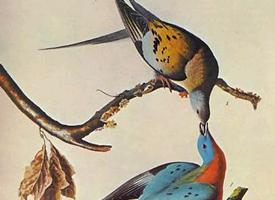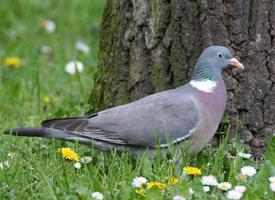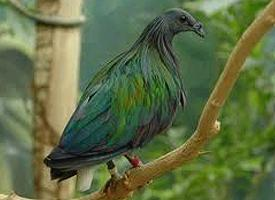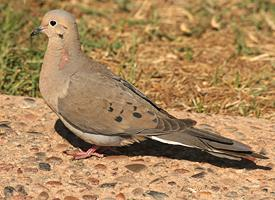
Stav ohrožení
| Vyhynulý |
Popis zvířete
The Passenger Pigeon, scientifically known as Ectopistes migratorius, was a bird species that once traversed the skies of North America in numbers so vast, they were almost beyond belief. With adult birds measuring about 40 cm (15.75 inches) in length and weighing approximately 340 to 400 grams (12 to 14 ounces), these pigeons were notable for their slender bodies, long tails, and powerful wings, which were adapted for long-distance flight. The male Passenger Pigeon was particularly striking, with its iridescent bronze and green neck feathers, blue-gray head, and red breast, while the female sported a more subdued palette of colors, featuring mainly gray and brown tones.Renowned for their incredible social nature, Passenger Pigeons lived in colossal flocks that could number in the billions, a sight so awe-inspiring that early accounts describe the sky darkening for hours as a flock passed overhead. These massive congregations were not only a defense mechanism against predators but also played a crucial role in their breeding and foraging behaviors. The birds were highly nomadic, constantly on the move in search of food, which primarily consisted of nuts, seeds, and fruits. Their feeding grounds shifted with the seasons, following the ripening patterns of wild fruits and the availability of acorns and chestnuts, which they consumed in vast quantities.
Breeding was a communal affair, with thousands, sometimes millions, of pairs nesting in close proximity in large tracts of suitable forests. These nesting sites, known as "pigeon towns," were a cacophony of coos and wing flutters, with each pair vigorously defending their small nesting territory. The female typically laid a single egg, which both parents took turns incubating. The hatchling, or squab, was fed on "pigeon milk," a nutrient-rich secretion produced by the crop of both parents, until it was ready to fledge.
Despite their once overwhelming numbers, the Passenger Pigeon's story is one of rapid decline and eventual extinction, primarily due to human activities. The 19th century saw the pigeon being hunted on an industrial scale for meat, which was cheap and thus highly sought after by an ever-growing human population. Additionally, vast tracts of the bird's forest habitat were cleared for agriculture and urban development, further diminishing their numbers. The last known Passenger Pigeon, a female named Martha, died in captivity in the Cincinnati Zoo in 1914, marking the end of a species that had once been among the most abundant birds on the planet.
The extinction of the Passenger Pigeon serves as a poignant reminder of the fragility of seemingly inexhaustible natural resources and the profound impact human actions can have on the natural world. It underscores the importance of conservation efforts and the need for sustainable practices to ensure that current and future species do not suffer a similar fate.
Podobná zvířata
Nové fotografie zvířat
Top 10 zvířat
- Chinese water dragon (Physignathus cocincinus)
- Galápagos tortoise (Geochelone nigra complex)
- Dolphin gull (Leucophaeus scoresbii)
- Japanese macaque (Macaca fuscata)
- Colombian red howler (Alouatta seniculus)
- Sea urchins (Echinoidea)
- Moustached guenon (Cercopithecus cephus)
- Diana monkey (Cercopithecus diana)
- Common reed warbler (Acrocephalus scirpaceus)
- Common house mosquito (Culex pipiens)


